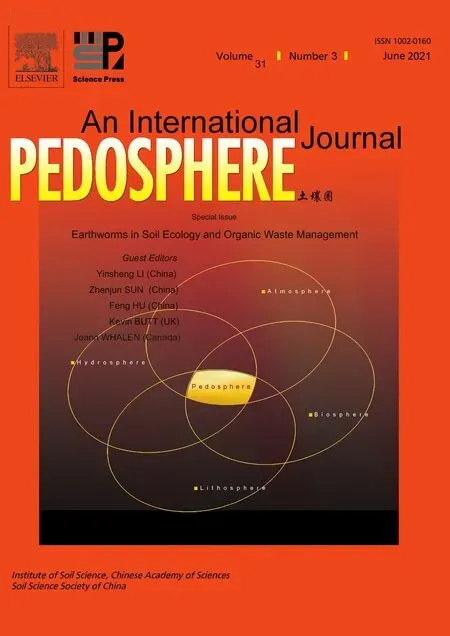Biological weathering of phlogopite during enriched vermicomposting
2021-07-16FaribaJAFARIHosseinKHADEMIVajiheSHAHROKHAngelFAZCANOJoseACOSTAandFarhadKHORMALI
Fariba JAFARI,Hossein KHADEMI,Vajihe SHAHROKH,Angel FAZ CANO,Jose A.ACOSTA and Farhad KHORMALI
1 Depar tment of Soil Science,College of Agriculture,Isfahan University of Technology,Isfahan 84156-83111(Iran)
2 Sustainable Use,Management and Reclamation of Soil and Water Research Group,Universidad Politécnica de Car tagena,Paseo Alfonso XIII,48,Cartagena,Murcia 30203(Spain)
3 Depar tment of Soil Science,Gorgan University of Agricultural Science and Natural Resources,Gorgan 49189-43464(Iran)
(Received September 23,2019;revised December 16,2019)
ABSTRACT As the dominant macrofauna in many soils,earthworms play a significant role in mineral weathering and nutrient release from mineral structures into available forms for root uptake.Phlogopite is a trioctahedral micaceous mineral that can be weathered to other minerals through release of its interlayer potassium(K).In this study,we investigated the effect of earthworm activities and associated microbial communities on phlogopite weathering during the production of phlogopite-enriched vermicompost with different quantities of phlogopite added.An experiment was run under laboratory conditions using three levels of phlogopite(0,20%and 40%by weight)in triplicates.Each Petri dish contained 20 g of a mixture of cow manure and phlogopite,and vermicomposting process was performed by inoculation of eight Eisenia foetida earthworms.Changes in clay mineralogy and C/N ratio in each dish were assessed at days 0,45,90,135,and 180 during vermicomposting.The results indicated that phlogopite was partially weathered to vermiculite and interstratified mica-vermiculite during the vermicomposting process.The rate of weathering was higher during the early stages of vermicomposting(the first 90 d).The weathering of phlogopite was influenced considerably by the activity of earthworms and associated microbial communities during the organic matter transformation process.At the early stages of the process,the weathering rate for different levels of phlogopite was not significantly different,but over time it accelerated steadily,and the difference increased.
Key Words: C/N ratio,earthworm,Eisenia foetida,enriched vermicompost,mineral weathering,weathering rate,X-ray diffraction
INTRODUCTION
Mineral weathering is an important process in soils,during which nutrient elements are released from mineral structures into the soil system and become potentially available for root uptake.This process also contributes to the pedological development of soils(Harley and Gilkes,2000).Furthermore,it can increase the cation exchange and water holding capacities of soils through the formation of silicate clay minerals(Dubbin,2001).
Micaceous minerals are common components of soils and sediments.Generally,di-and/or trioctahedral types of mica minerals contain potassium(K)between the layers.In fact,during the formation of micaceous minerals,the substitution of aluminum(Al)cations for silicon(Si)results in a negative charge that is neutralized by interlayer K(Bailey,1984).Micaceous minerals are a major source of K in soils,and therefore,their weathering has been the topic of numerous studies(Schulze,2002).The results of most studies have shown that interlayer Kis released during the weathering of micaceous minerals and,subsequently,other minerals such as vermiculite and smectite are formed(Hinsingeret al.,1992;Hinsinger and Jaillard,1993;Calvarusoet al.,2009;Naderizadehet al.,2010).
Several studies have shown the role of bacteria(Barkeret al.,1998;Sheng and He,2006),fungi(Martin and Sparks,1985;Pinzariet al.,2016),plants rhizospheric zone(Hinsingeret al.,1992;Hinsinger and Jaillard,1993;Wanget al.,2000;Moritsukaet al.,2004;Calvarusoet al.,2009;Naderizadehet al.,2010),and earthworms(Needhamet al.,2004;Carpenteret al.,2007)on mineralogical changes of micas.Extracellular organic and inorganic acids produced by bacterial activities have been reported to facilitate the release of Al,iron(Fe),and Si from biotite(Barkeret al.,1998).In addition,Goudie(1996)reported that plant roots and microorganisms could enhance the rate of mineral weathering through biochemical and biomechanical processes.Pinzariet al.(2016)investigated the routes of phlogopite weathering by fungi,and consequent mineralogical changes,and found that acidification and mechanical disruption might accelerate the weathering of phlogopite.
Some studies have focused on the vermiculitization of trioctahedral micas in the root zone(Hinsingeret al.,1993;Hinsinger and Jaillard,1993;Naderizadehet al.,2010),Hinsinger and Jaillard(1993)observed mineralogical changes of phlogopite in the rhizosphere of ryegrass,which take place because of a reduction in K concentrations in the soil solution in the vicinity of the root surface due to K uptake,Naderizadehet al.(2010)reported that mineralogical changes in clay-sized muscovite and phlogopite were affected by root activities and organic matter transformation through increasing rhizosphere acidity and Krelease from micaceous minerals.
Mineral degradation by earthworms can be associated with high mechanical grinding action,bacteria-rich microenvironmental conditions,and low pH of the earthworm gut as well as high levels of ligands of gut microbial origin(Needhamet al.,2004;Carpenteret al.,2007).Carpenteret al.(2007)indicated that the earthworm(Eisenia veneta)accelerated the weathering of biotite,anorthite,kaolinite,and smectite.They also suggested that the earthworms’gut microbes might play an important role in increasing the rate of mineral weathering.Liuet al.(2011)investigated the role of the earthwormPheretima carnosaand the response of its gut bacterial communities on the degradation of K-feldspar.Their findings indicated that weathering of such silicate minerals was accelerated by earthworms and microorganisms.
Vermicompost,as the final product of organic matter transformation in the presence of composting earthworms,is now considered as one of the best biofertilizers owing to its high levels of microbial populations and nutrient content.Despite these advantages,one of the limitations of extensive application of vermicompost in the field is the necessity to use large amounts in order to achieve a detectable yield increase.To remedy this,vermicompost enrichment through the addition of inorganic materials and/or microflora has been proposed as a way to enhance its beneficial properties and also to reduce the field work and cost of fertilizer transport and application(Busatoet al.,2012).
Several studies have investigated the effect of vermicompost enrichment with micas and other K-bearing minerals(Nishanth and Biswas,2008;Liuet al.,2011;De Souzaet al.,2013;Meena and Biswas,2013;Zhuet al.,2013).Zhuet al.(2013)determined the quantity of available K in vermicompost enriched with different ratios of K-bearing mineral powder.Their results indicated that the amount of available K was significantly increased due to the addition of K-bearing minerals.Liuet al.(2011)also investigated vermicompost enrichment with K-bearing minerals and reported that the contents of soluble and nitric acid-extractable K were increased significantly over a short period of time.
To date,the studies carried out on the enrichment of vermicompost by K-bearing minerals indicate that constituent minerals are weathered,releasing K from the mineral layers during the process of enriched vermicompost production.However,no study has yet reported the rate of mica mineral weathering during the vermicomposting process.Such investigation is needed to clearly understand effects on the mineral structure of mica over time as the vermicomposting process is completed.Therefore,the objectives of this research were:i)to evaluate the rate of biological weathering of phlogopite with time in phlogopite-enriched vermicompost and ii)to examine how different levels of added phlogopite would influence the weathering rate.
MATERIALS AND METHODS
Preparation of materials used in the experiment
Phlogopite was obtained from the Azar Talgh Company,Iran.It was then ground and sieved,and the fine particle fraction(<60μm)was used in the experiment.This fraction was selected to promote weathering and build on previous studies that used coarser particles(Suzukiet al.,2003;Carpenteret al.,2007).The purity of the phlogopite was determined using X-ray fluorescence(XRF)(Table I)and X-ray diffraction(XRD).
As the source of organic carbon(C),cow manure was obtained from Isfahan University of Technology Educational and Research Farm.In order to remove any extra ammonia and soil particles,particularly clay particles,the manure was thoroughly washed(Khademi and Arocena,2008),dried,powdered,and finally passed through a 2-mm sieve before being used in the experiment.
The earthworm speciesEisenia foetidawas chosen for the experiment.This species of earthworm has been widely employed by researchers because of its high rate of proliferation and good compatibility with laboratory environments(OECD,1984).To conduct the experiment,mature earthworms were washed with water and then transferred to Petri dishes containing moistened filter papers.In order to deplete their gut contents,no nutrients were supplied for 36 h(Carpenteret al.,2007).They were then added to the experimental substrates.

TABLE IChemical composition of the phlogopite used for vermicompost enrichment in the experiment
Experimental design
The experiment was carried out in a completely randomized design with triplicates.Treatments included three levels of phlogopite:0,20%,and 40%by weight.
Twenty grams of a mixture of cow manure and phlogopite were added to each Petri dish(Table II),and eight earthworms were added to each dish as suggested by Carpenteret al.(2007).All the Petri dishes were placed in a dark room.During the experimental period,maximum and minimum environmental temperatures were 30 and 20°C,respectively,and the relative humidity was maintained at 40%—45%.The moisture content of the mixture in all the Petri dishes was kept between 70%and 75%.

TABLE IISetup of the phlogopite-enriched vermicomposting experiment
At days 0,45,90,135,and 180 of vermicomposting,three Petri dishes from each treatment were retrieved.The contents of the dishes were oven-dried at 30°C,powdered,and passed through a 2-mm sieve.Subsequently,the samples were analyzed to determine the quantity of organic C and total nitrogen(N)and clay mineralogical changes.
Laborator y analyses
Organic C content of the samples was measured by the wet oxidation(Walkley-Black)method(Nelson and Sommers,1996)and total N by the Kjeldahl method(Bremner,1996).
Prior to XRD analyses,soluble salts,carbonates,organic C,and free Fe oxides of the samples were removed by washing with distilled water,followed by treatment with a mixture of acetic acid and sodium acetate(1 mol L-1)buffered at pH 5,30%H2O2,and finally dithionate citrate bicarbonate(Jackson,1979).The clay fraction of the samples was then separated by centrifugation(Jackson,1979).Afterwards,the clay fraction was saturated with Mg or K and mounted on individual glass slides with a preferential orientation.The Mg-saturated samples were solvated with ethylene glycol(Mg-Eg),while the K-saturated samples were heated at 550°C(K-550)(Jackson,1979).Prepared slides were subsequently examined using a Bruker AXS D8 diffractometer(Bruker,USA)with CuKαradiation generated at 40 kV and 30 mA.
The above-mentioned four treatments performed on the clay fractions were needed to differentiate different minerals.Phlogopite-vermiculite is characterized by a 1.0—1.4 nm diagnostic peak that is unaffected by ethylene-glycol treatment and collapses to 1.0 nm after heating to 550°C.Vermiculite has a basal peak at about 1.4 nm that is not affected by ethylene-glycol saturation and shifts to nearly 1.1 nm by heating at 550°C.Chlorite is identified based on its basal reflections at 1.41—1.47,0.70—0.72,and 0.351—0.352 nm.Phlogopite has a major peak at 0.98—1.0 nm.Smectite is identified by its basal reflection at 1.41—1.50 nm that shifts to 1.71—1.75 nm with ethylene-glycol saturation and collapses to 0.99—1.01 nm after heating at 550°C(Jackson,1979).
The quantities of the major elements in micaceous minerals were determined by XRF using a Philips PW 2400 spectrometer(Philips,The Netherland).The loss on ignition was measured according to the method described by Lim and Jackson(1982).
Since the quantity of cow manure was not equal across treatments(Table I),the amount of impurities of clay minerals present varied.To account for this,X-ray diffractograms of the day 0 samples of each treatment were considered as the control.
RESULTS AND DISCUSSION
XRD patterns of clay fractions present in the phlogopite and cow manure
X-ray diffractograms obtained for the clay fractions of the phlogopite sample used in the experiment and those of the clay fraction found in the cow manure are presented in Figs.1 and 2,respectively.In Fig.1,the 1.0-and 0.33-nm peaks in the Mg-saturated samples were attributed to micaceous clay minerals.Trioctahedral micaceous minerals are characterized by a low intensity 0.5-nm peak,whereas dioctahedral micaceous minerals are marked by a sharp and strong 0.5-nm peak(Fanninget al.,1989).The low intensity peak at 0.5 nm in Fig.1 further confirmed the trioctahedral nature of the micaceous mineral.Moreover,a weak 1.4-nm peak was observed in the Mg-saturated and Mg-Eg samples yet was absent in the K-saturated sample(along with an increase in the 1.0 nm peak intensity),indicating the presence of impurities related to the mineral vermiculite.

Fig.1 X-ray diffractograms of the clay fraction of the phlogopite used in the vermicomposting experiment after Mg-saturated(Mg),Mg-saturated and ethylene glycol-solvated(Mg-Eg),K-saturated(K),or K-saturated and heated at 550°C(K-550)treatments.
Peaks at 1.0,0.5,and 0.33 nm observed in the Mgsaturated sample(Fig.2)also indicated the presence of micaceous minerals.The XRD peak at 1.4 nm in the Mgsaturated sample was used as an indicator to identify smectite,vermiculite,and chlorite minerals.An X-ray diffraction peak at 1.72 nm in the Mg-Eg treated samples showed mineral expansion and confirmed the presence of smectite.In the K-saturated sample,the increased intensity of the 1.0-nm peak proved the presence of vermiculite and eventually,the 1.4-nm peak in the K-550 samples illustrated the presence of chlorite clay minerals.The cow manure in the VP0 treatment showed the presence of a low concentration of mica,smectite,vermiculite,and chlorite minerals at day 0.
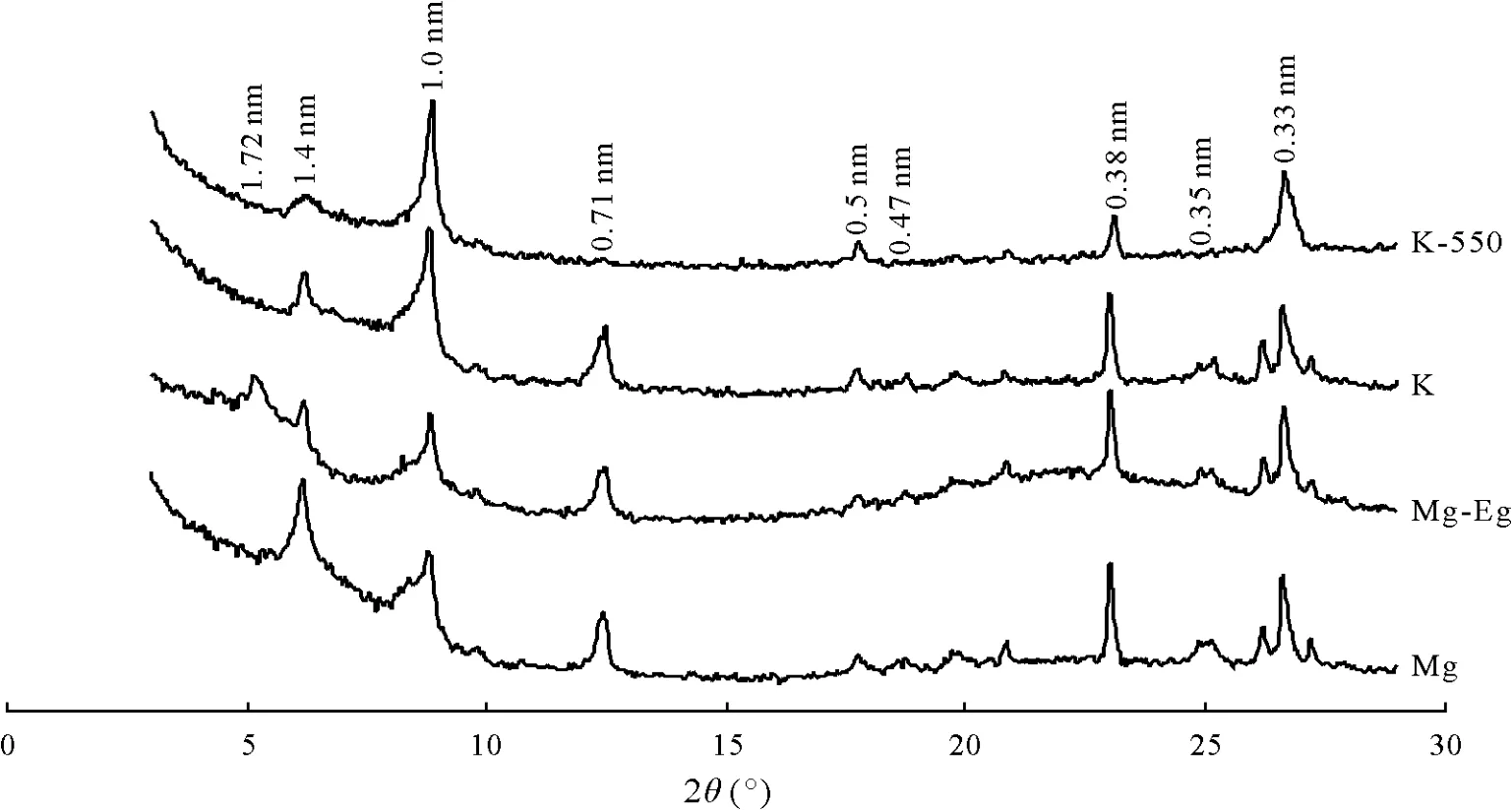
Fig.2 X-ray diffractograms of the clay fraction present in the cow manure used in the phlogopite-enriched vermicomposting experiment after Mg-saturated(Mg),Mg-saturated and ethylene glycol-solvated(Mg-Eg),K-saturated(K),or K-saturated and heated at 550°C(K-550)treatmeants.
The XRD patterns for the treatments VP20 and VP40 at day 0 are shown in Fig.3.They reveal an abundance of phlogopite and low quantity of smectite,vermiculite,and chlorite minerals.The difference between these two treatments is related to the intensity of the 1.4-nm peak in the Mg-saturated and Mg-Eg samples.The 1.4-nm peak is more intense in the VP20 treatment as compared to the VP40 treatment since the former contains more impurities than the latter.
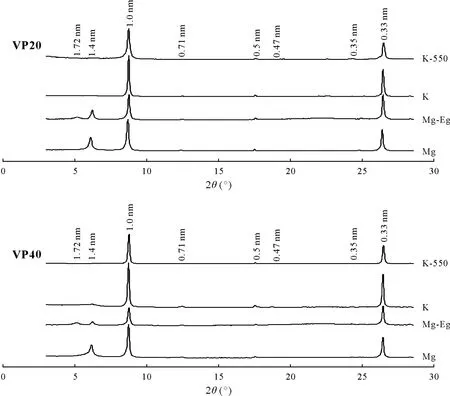
Fig.3 X-ray diffractograms of the clay fractions from the VP20 and VP40 treatments at day 0 of the vermicomposting experiment after Mg-saturated(Mg),Mg-saturated and ethylene glycol-solvated(Mg-Eg),K-saturated(K),or K-saturated and heated at 550°C(K-550)treatments.VP20=16 g cow manure+4 g phlogopite;VP40=12 g cow manure+8 g phlogopite.
Clay mineralogical changes during the vermicomposting process
The X-ray diffractograms of the Mg-saturated clay fraction of the cow manure in the VP0 treatment during vermicomposting are presented in Fig.4.No detectable mineralogical changes occurred in the clay fraction of the cow manure without addition of phlogopite during vermicomposting.
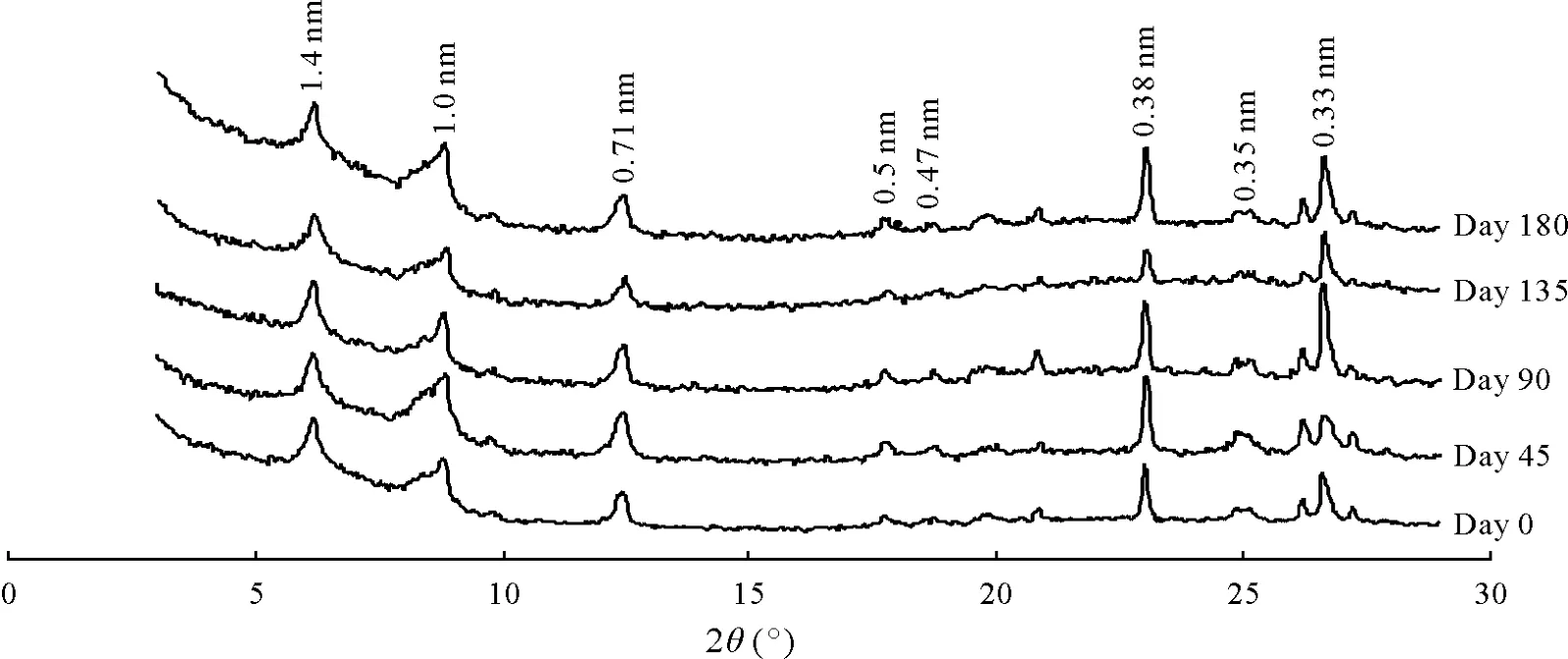
Fig.4 X-ray diffractograms of the Mg-saturated clay fraction from the VP0 treatment during the vermicomposting process at days 0,45,90,135,and 180.VP0=20 g cow manure+0 g phlogopite.
Figure 5 shows the X-ray diffraction patterns of Mgsaturated clay particles in the VP20 and VP40 treatments during vermicomposting.These patterns showed mineralogical variations of phlogopite at two levels(20%and 40%by weight)during vermicomposting.In both treatments,the intensity of the 1.0-nm peak decreased with time,whereas that of the 1.4-nm peak increased.In addition,the increase in intensity of the 1.4-nm peak with time belonging to the new phase indicated that the weathering rate was initially high.This is probably owing to the availability of more nutrient elements for microorganisms and earthworms,and also due to the availability of smaller-sized and more easily weatherable particles in the added phlogopite.Phlogopite transformation seems to have taken place at lower rates in the later stages because of the reduction in the nutrient level,the competition of microorganisms,and the more resistant and coarser phlogopite particles left over.
Figure 5 also clearly indicates that,based on the intensity of the 1.4-nm peak belonging to the new phase,the weathering rate of phlogopite in VP20 was higher than that in VP40.Mousavi(2012)investigated the weathering rate of different quantities of phlogopite(equivalent to 0.2%,0.4%,0.8%,and 1.4%K2O)in the root zone of barley.Her investigation also indicated that the increase in mineral content reduced the weathering rate.
The changes in the intensity of the 1.4-nm peak(Fig.5)occurred as a result of the activities of the earthworms and the microorganisms in the earthworm gut and the manure.This is supported by a previous study by Carpenteret al.(2007)in which the earthwormE.foetidaaccelerated the weathering of anorthite,smectite,kaolinite,and biotite minerals.These authors attributed such an increase in the weathering rate of these minerals to the ligands produced by earthworm digestive systems and/or microbial communities present in the earthworm gut.
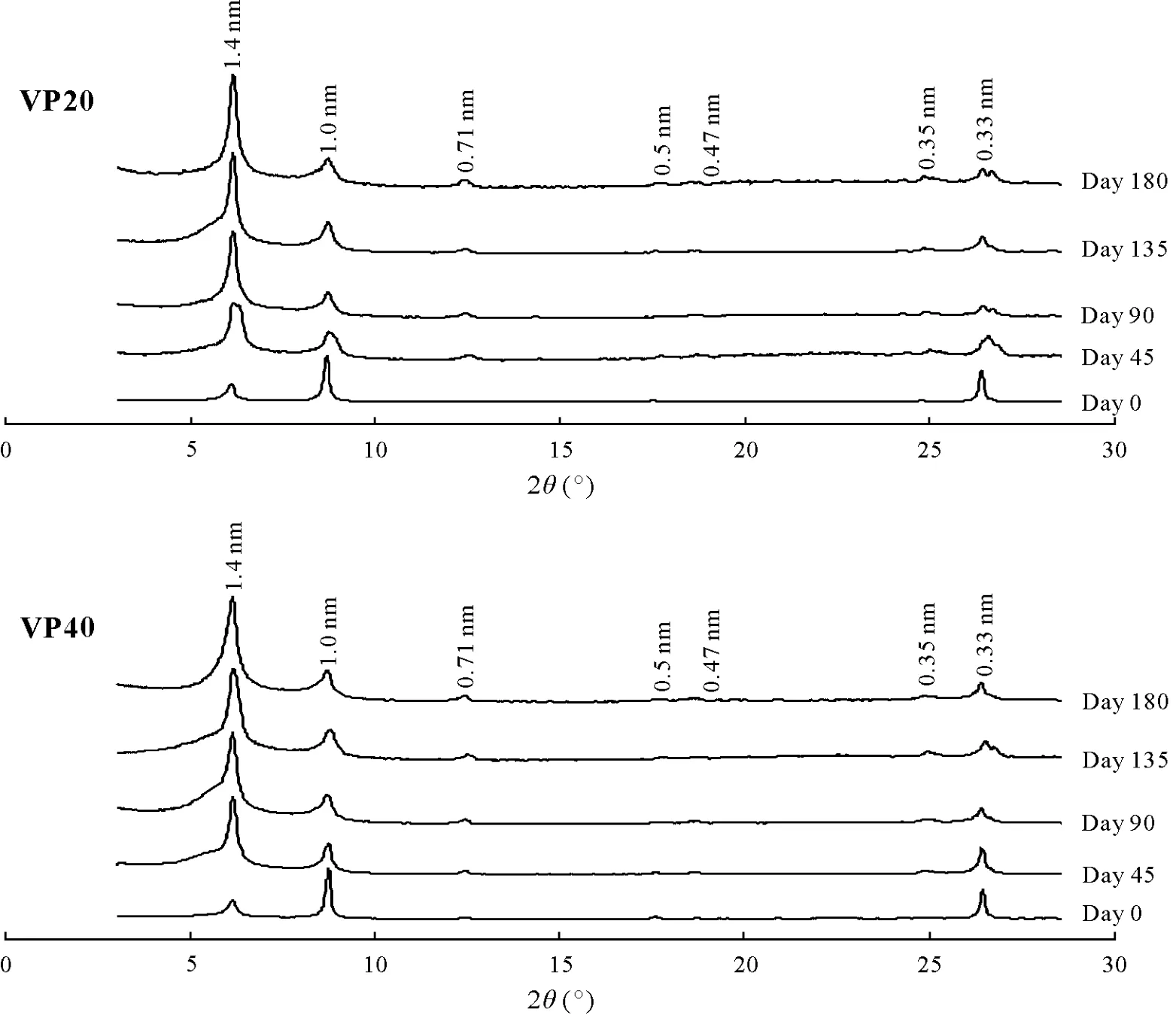
Fig.5 X-ray diffractograms of the Mg-saturated clay fractions from the VP20 and VP40 treatments during the vermicomposting process at days 0,45,90,135,and 180.VP20=16 g cow manure+4 g phlogopite;VP40=12 g cow manure+8 g phlogopite.
Factors affecting mineral weathering by earthworm activity include a reduction in pH,mechanical grinding caused by earthworm digestive system movements,and the formation of ligand complexes with mineral ions generated by earthworm digestive systems or bacterial communities in the earthworm gut or both(Needhamet al.,2004;Carpenteret al.,2007).Liuet al.(2011)claim that earthworms play a significant role in ecosystem processes since they not only influence the soil structure,but also have a great effect on nutrient cycling through mineral weathering and organic matter transformation.Moreover,these investigators studied the effect of earthworm activities and their gut microbial communities on K-feldspar weathering.They reported that the ecosystem of metabolic networks formed by the microorganisms and earthworms might increase the weathering process.On the other hand,organic acids produced by the transformation of organic matter might influence the changes in phlogopite mineralogy through the formation of different complexes with various elements(Fig.5).Several studies have evaluated the accelerating effect of organic matter transformation on the weathering of minerals(Rosset al.,1985;Ugolini and Sletten,1991;Lucas,2001;Lindrooset al.,2003;Naderizadehet al.,2010).Lindrooset al.(2003)found that the presence of organic matter in soil could have a significant effect on mineral weathering and release of elements.They also suggest that carbon dioxide(CO2)produced by the respiration of roots and microorganisms was the other factor affecting the release of nutrient elements from minerals into the rhizosphere.Naderizadehet al.(2010)reported that organic matter transformation and root activities enhanced the acidity of the rhizosphere and facilitated K release from trioctahedral phlogopite as well as transformation of this mineral to vermiculite,and to some extent,to smectite and a minor quantity of chlorite.
The X-ray diffraction patterns of differently treated clay fractions separated from the treatments of VP0,VP20,and VP40 at days 45,90,135,and 180 of the vermicomposting process are shown in Figs.6,7,and 8,respectively.Mica(phlogopite),chlorite,smectite,vermiculite,and an interstratified mica-vermiculite mineral(M/V)were the dominant clay minerals found in the samples from the VP20 and VP40 treatments(Figs.7 and 8).The results demonstrated that vermiculite and M/V were new clay minerals formed through phlogopite biological weathering,when compared to the samples at day 0(Fig.3).The higher intensity of the 1.4-nm peak in Mg-saturated samples at different periods in comparison to day 0,as well as the enhanced intensity of the 1.0-nm peak of K-saturated samples,indicated the vermiculitization of phlogopite.Martin and Sparks(1985),Hinsingeret al.(1992),Hinsinger and Jaillard(1993),and Hinsingeret al.(1993)have highlighted the influence of plant roots and fungi,and their biological products,on the weathering of trioctahedral micaceous minerals such as phlogopite and biotite in the rhizosphere.Their findings also support the vermiculitization of these minerals.

Fig.7 X-ray diffractograms of the clay fraction from the VP20 treatment at days 45,90,135,and 180 of the vermicomposting process after Mg-saturated(Mg),Mg-saturated and ethylene glycol-solvated(Mg-Eg),K-saturated(K),and K-saturated and heated at 550°C(K-550)treatments.VP20=16 g cow manure+4 g phlogopite.

Fig.8 X-ray diffractograms of the clay fractions from the VP40 treatment at days 45,90,135,and 180 of the vermicomposting process after Mg-saturated(Mg),Mg-saturated and ethylene glycol-solvated(Mg-Eg),K-saturated(K),and K-saturated and heated at 550°C(K-550)treatments.VP40=12 g cow manure+8 g phlogopite.
In addition,the XRD patterns of the K-saturated and 550°C-heated samples(Figs.7 and 8)indicated the appearance of a new peak at 1.2 nm,which was not found in the day 0 samples(Fig.1).This new phase suggests the formation of a new clay mineral that might be an interstratified micavermiculite mineral.Shahrokhet al.(2019)studied the effect of lemon roots on soil clay mineralogical changes and reported the transformation of illite into interstratified illite-smectite and vermiculite under rhizospheric conditions.
Comparison of the X-ray diffractograms in Figs.7 and 8 with those in Fig.6 showed that the 1.2-nm peak existed only in phlogopite-containing samples.This seems to be a transitional phase(interstratified mica-vermiculite)resulting from phlogopite weathering.In fact,during the weathering of micaceous minerals,K is usually released from interlayer sites and micas are transformed to clay minerals such as vermiculite,smectite,and interstratified minerals(Bighamet al.,2001).Rahimzadehet al.(2015)investigated K release from glauconite in canola rhizosphere inoculated with silicate-dissolving bacteria.Their results showed that the major process occurring in the rhizosphere was related to mica weathering,during which interlayer K was released and expandable minerals including vermiculite and smectite were formed.
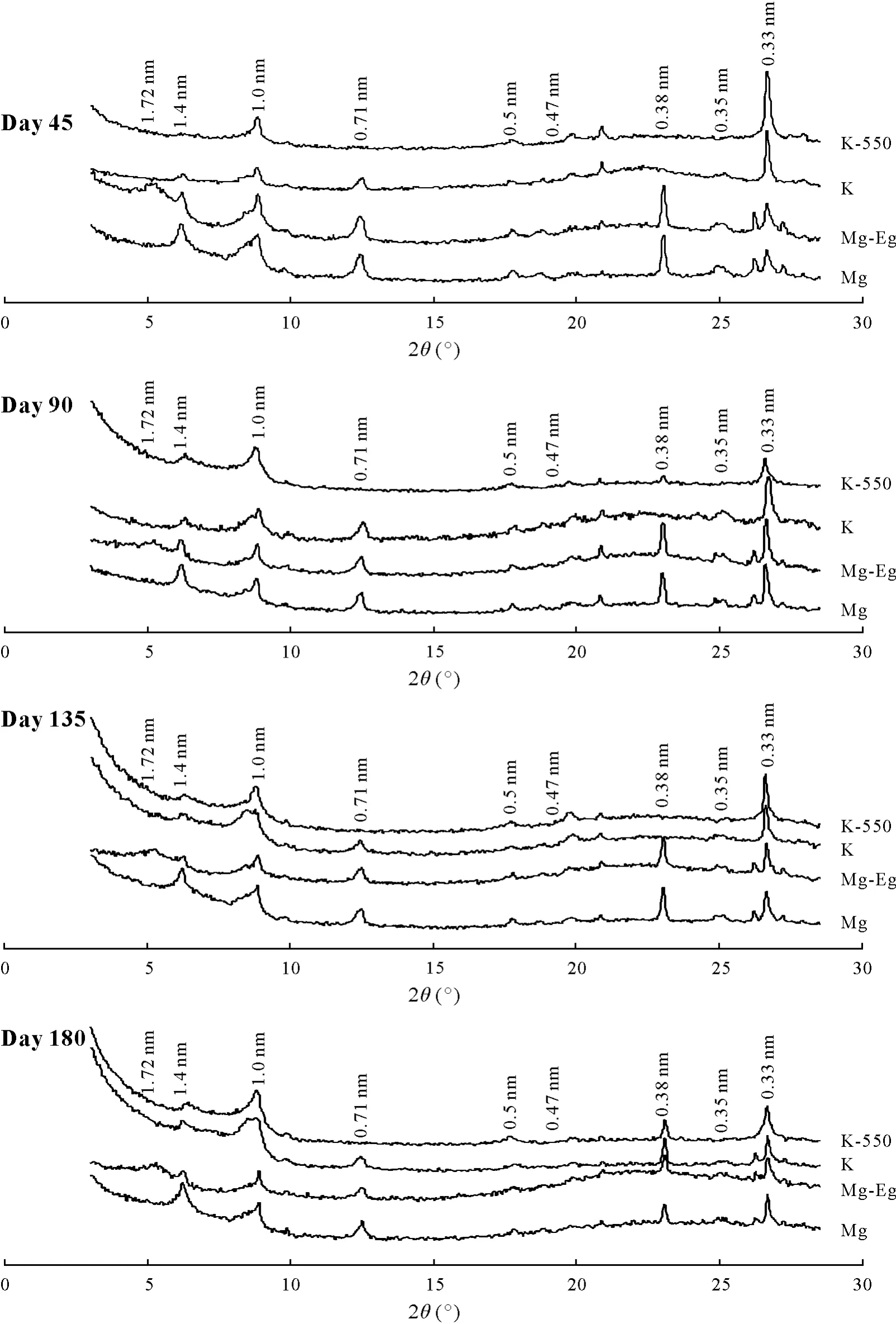
Fig.6 X-ray diffractograms of the clay-sized particles from the VP0 treatment at days 45,90,135,and 180 of the vermicomposting process after Mg-saturated(Mg),Mg-saturated and ethylene glycol-solvated(Mg-Eg),K-saturated(K),and K-saturated and heated at 550°C(K-550).VP0=20 g cow manure+0 g phlogopite.
The results indicate that phlogopite particles are broken down by the gut muscles of the earthworms,mixed with organic acids and digestive enzymes secreted from the gut as well as the existing microorganisms,and weathered to other minerals.Many researchers have reported that earthworms cause mechanical degradation of soil particles through swallowing and digesting the particles.Edwards and Bohlen(1996)stated that coarse mineral particles were broken down by the activity of the gut muscles when passing through an earthworm’s digestive system.Carpenteret al.(2007)reported that earthworms,through physical degradation of minerals,increased the surface area of the minerals and,as a result,accelerated the degradation of minerals.
Changes in XRD peak intensity and C/N ratios of phlogopitecontaining treatments during the vermicomposting process
Temporal changes in the intensity ratio of the 1.4-to 1.0-nm peaks of the Mg-saturated samples from the phlogopitecontaining treatments are shown in Fig.9.The intensity ratio of the 1.4-to 1.0-nm peaks was used for two reasons.Firstly,the 1.0-nm peak,the major peak of phlogopite(and other micaceous minerals),was also present in the original sample with a low intensity,while the 1.4-nm peak was related to the newly formed clay mineral.Therefore,this ratio was a suitable index for investigating the rate of phlogopite transformation.Secondly,by examining this ratio,the effect of a minor quantity of impurities in the original phlogopite mineral and also that of a negligible quantity of clay present in cow manure are eliminated.Several researchers have already used this ratio to investigate mineral weathering(Naderizadehet al.,2010;Rahimzadehet al.,2015).According to Rahimzadehet al.(2015),the highest 1.4/1.0 nm peak intensity ratio was 7.58 for a sample containing glauconite and silicate-dissolving bacteria in the rhizosphere of canola plants.
In Part A of the plot in Fig.9,the weathering rate was initially similar in both the VP20 and VP40 treatments.This could be attributed to the fact that at the early stage of vermicomposting,organic materials were fresh and,thus,decomposed at a relatively higher rate.Therefore,this might have resulted in accelerated weathering of mica(phlogopite)in the substrate.In the second part of the plot(B),the peak intensity ratio for VP20 was higher than that for VP40,which appears to be due to the smaller amount of micaceous minerals in the former sample and,consequently,higher probability of contact with organic compounds being decomposed by microorganisms and earthworms.At the last stage(C),there was only a slight increase in the peak intensity ratio for both treatments and both reached a similar steady state condition where further biological weathering was extremely slow,unless conditions such as organic matter quality and quantity,microbial and earthworm populations,and environmental parameters were changed again.It seems that most of the readily decomposable compounds in the original manure,as well as the most highly weatherable fraction of phlogopite(very fine particles),underwent changes before the end of phase C(Fig.9).This may explain why the plots for both treatments converged again in Part C.
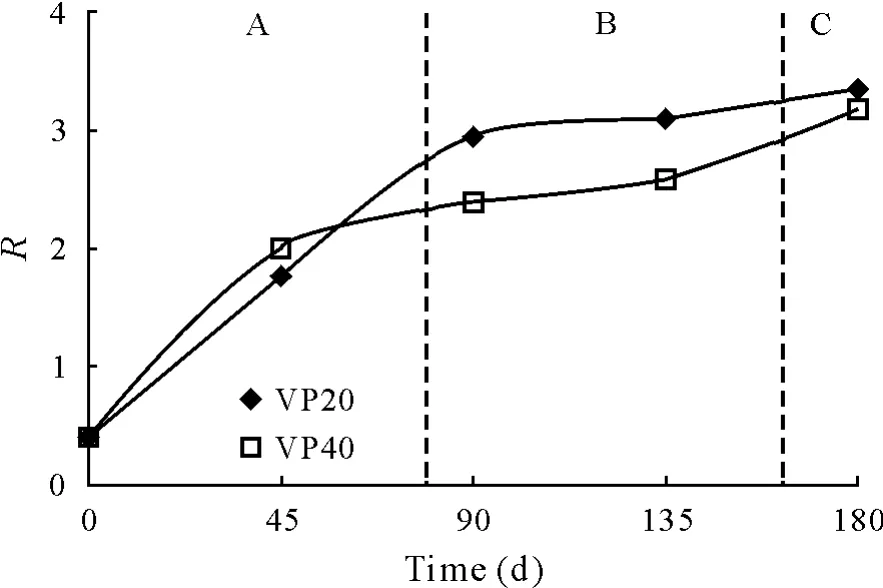
Fig.9 Changes in intensity ratio(R)of 1.4-to 1.0-nm peaks of the Mg-saturated clay fractions from the VP20 and VP40 treatments during the vermicomposting process.VP20=16 g cow manure+4 g phlogopite;VP40=12 g cow manure+8 g phlogopite.
Temporal changes in C/N ratio of the samples from the phlogopite-containing treatments are shown in Fig.10.At the early stages of vermicomposting,the rate of manure decomposition was high and the gradient(slope of the line)decreased with time.The C/N ratio reduced from 23 at the beginning to approximately 13 after 180 d.The C/N ratio of less than 20 indicates a high degree of organic matter transformation and an acceptable level of compost stability(Metzger,2001).Different stages of phlogopite transformation to vermiculite and other minerals,shown in Fig.9,seem to match well with those of manure decomposition by earthworms and microorganisms indicated by changes in the vermicompost C/N ratio(Parts A,B,and C in Fig.10).
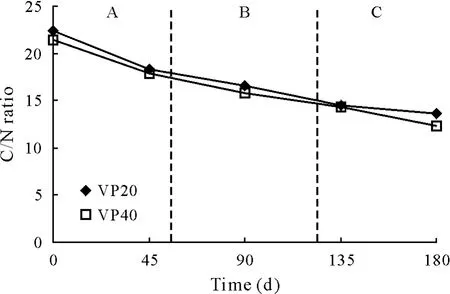
Fig.10 Changes in C/N ratio of the Mg-saturated clay fractions from the VP20 and VP40 treatments during the vermicomposting process.VP20=16 g cow manure+4 g phlogopite;VP40=12 g cow manure+8 g phlogopite.
During transformation of organic matter,soluble sugars are initially removed,followed by polysaccharides,cellulose,hemicellulose,and finally lignin(Alef and Nannipieri,1995).Because of the complexity and diversity of various bonds in lignin,this material is more resistant to microbial degradation than carbohydrates(Sollinset al.,1996).
CONCLUSIONS
During the production of silicate-enriched vermicompost(e.g.,enriched with phlogopite),both decomposition of organic compounds and transformation of mineral phases occur.The latter process is not only affected by the former,but also influenced by the activities of earthworms and those of their associated microorganisms.This investigation provides evidence of the alteration of clay fraction in phlogopite to vermiculite and interstratified M/V during the production of vermicompost.Such transformation,in turn,improves the nutritional value of the vermicompost produced.
The analysis of inorganic and organic constituents in vermicompost clearly showed that both mineral weathering and organic decomposition processes occurred concurrently.The XRD analysis indicated that the weathering rate of phlogopite was initially high.Upon reaching the final stages of vermicomposting,the weathering rate reached a stable state.Different ratios of phlogopite added to manure caused a small difference in weathering rates at the early stages of the process.This difference and the overall weathering rate of phlogopite increased steadily over time.Eventually,the difference in weathering rates of phlogopite between the two different levels of phlogopite addition decreased again and then continued at a stable rate.
In the current research,the mechanisms of phlogopite weathering by earthworms and microorganisms associated with manure were not investigated.To clearly distinguish the role of different processes on mineral weathering,further investigations should be carried out in the future.
ACKNOWLEDGEMENTS
The authors appreciate the comments,criticisms,and suggestions of three anonymous reviewers who carefully reviewed this manuscript.We would like to thank the Iranian National Science Foundation(No.96002378)for financially supporting this research.We would also like to thank Isfahan University of Technology,Iran,and Technical University of Cartagena,Spain,for providing laboratory facilities to carry out this investigation.
杂志排行
Pedosphere的其它文章
- Preface Earthworms in soil ecology and organic waste management
- Letter to the Editor Field and laboratory investigations of Lumbricus badensis ecology and behaviour
- Strategies to mitigate the adverse effect of drought stress on crop plants—influences of soil bacteria:A review
- Advances in fungal-assisted phytoremediation of heavy metals:A review
- Study of oxidative stress cadmium(Cd)-induced in Eisenia fetida based on mathematical modeling
- Behavior and respiration responses of the earthworm Eisenia fetida to soil arsenite pollution
